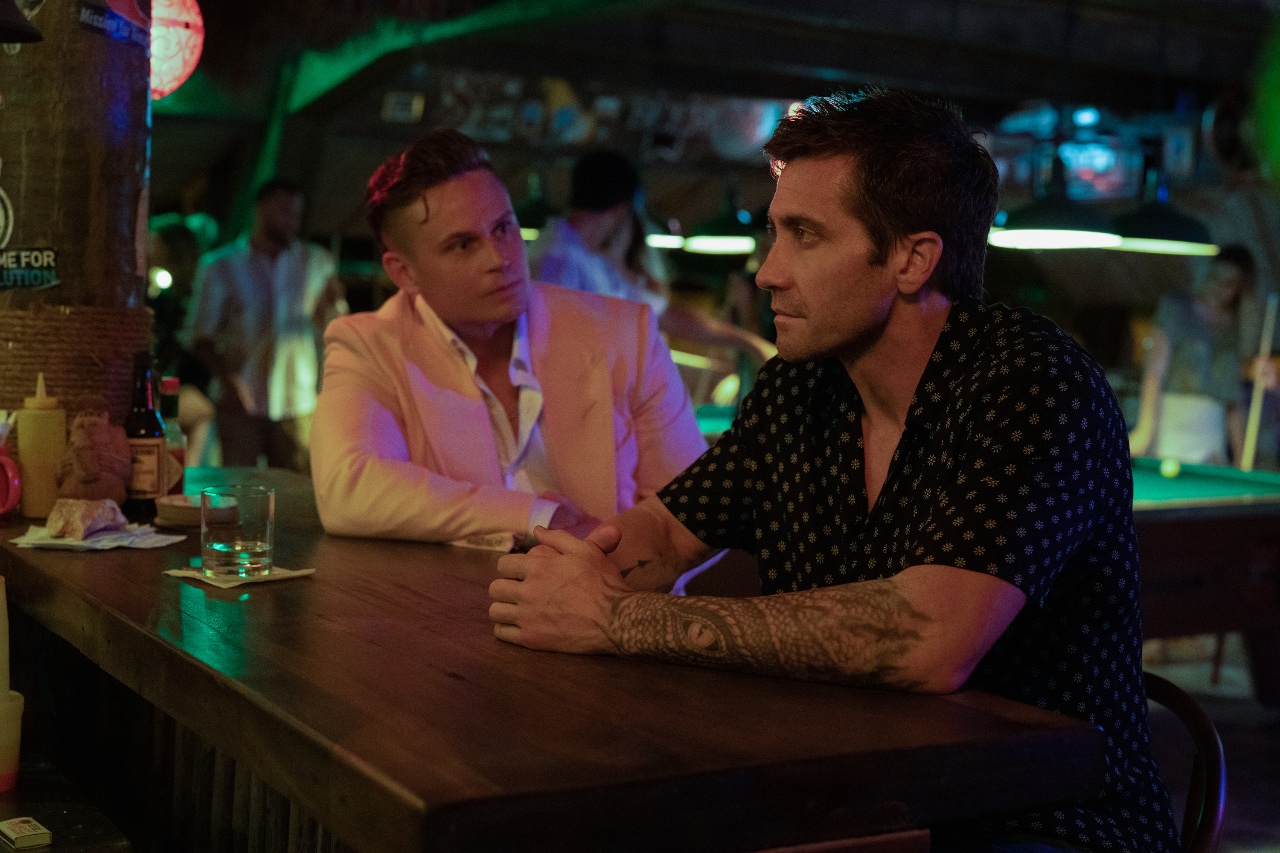
The second act of the 2024 remake of Road House climaxes with a nasty knockdown fight between UFC fighter turned bouncer Dalton (Jake Gyllenhaal) and Knox (UFC fighter turned actor Conor McGregor). Squishy sounds of smacked meat mix with a thumping rock song, like a second rhythm track every time the two ruffians punch each other. Early in the fight, the camera switches to first-person view as Knox batters his opponent before swinging around as Dalton takes his turn. It’s all bathed in yellow light, with the sickly glow cut only by neon beer signs hanging on the walls.
In short, the Road House remake is trash.
But it is wonderful trash, full of cheeseball crowd-pleasing, gnarly action, and some genuine humor. Road House had me cheering and pumping my fist in the air. Well, it would have, had I been watching it in a movie theater full of fans ready to have a good time. Instead, I was watching it alone in my office, waiting for a football commercial to interrupt the carnage.
The 2024 Road House is exactly the type of movie that benefits from the modern theatrical experience, complete with misbehaving moviegoers and ineffective cineplex sound proofing. It’s a glorious mess of a film that we should all be enjoying together, not alone in our homes.
Road House, Not the Movie House
The overwhelming majority of people will watch Road House streaming on Amazon. A few people got to see it in a theater when Road House premiered at South by Southwest. But director Doug Liman (The Bourne Identity, Edge of Tomorrow) is not one of them.
Liman made a show of dropping out of his movie’s premier to protest against the fact that MGM, the venerable movie studio now owned by Amazon, sent his movie straight to streaming. “The facts,” Liman wrote in an op-ed for Deadline. “I signed up to make a theatrical motion picture for MGM. Amazon bought MGM. Amazon said make a great film and we will see what happens. I made a great film.” Liman’s star Gyllenhaal calls his claims into question, telling Total Film that “Amazon was always clear that it was streaming.”
The facts of these contract negations don’t matter for most movie fans. What matters is how we watch movies. Amazon does have a history of giving the films it distributes a theatrical run, allowing The Big Sick, You Were Never Really Here, and The Sound of Metal to play in front of crowds for a few weeks before added to the streaming rotation. At the same time, Amazon competes with Netflix and Warner Brothers to create a viable streaming service, they not only try to curate a compelling library (thus, Amazon’s purchase of MGM), but also try to create new works that can only be accessed through them.
It’s easy to see why streamers like Amazon or Netflix want to keep their movies out of theaters. They want us to subscribe and give them money every month or year, not shell out $15 one time to pick and choose.
But it’s more important to see why movie fans want to preserve the theatrical experience. Even as theaters get worse and worse, subjecting us to twenty minutes of soda commercials and then thirty minutes of trailers we already watched online before getting to the actual movie, the communal element cannot be beaten.
Some movies work better when watched with a crowd, even if that crowd includes loud snackers, phone checkers, and seat kickers. And Road House is absolutely one of them.
The Lowbrow Beauty of Road House
Like its 1989 predecessor, 2024’s Road House is a slick piece of a b-movie trash. Gyllenhaal’s Elwood Dalton is an MMA fighter haunted by a tragedy in the ring, who spends his time challenging amateurs for money or contemplating suicide. Dalton finds purpose when bar owner Frankie (Jessica Williams) hires him to protect her establishment from the ruffians who drop by to scare away business, all part of a plot by businessman Ben Brandt (Billy Magnussen) to drive her out of town.
The script by Anthony Bagarozzi and Charles Mondry borrows the same basic plot as the 1989 Patrick Swayze original, directed by Rowdy Herrington and written by David Lee Henry and Hilary Henkin. However, Liman updates the story with modern aesthetics, both in terms of filmmaking and production design. Gone are the neon-lighting and perfect coifs of the 1989 version, replaced by shaky cameras, sweaty faces, and endless tattoos. The movie takes pleasure in the unpleasant sights and sounds of fists in faces, even when the story goes to outrageous places.
And rest assured, Road House gets very outrageous. Instead of Swayze’s sexy philosopher, Bagarozzi and Mondry reimagine Dalton as a wholesome nice guy, who happens to be really good at hurting people. In his first fight scene against a group of thugs, Dalton takes a moment to check on his adversary’s insurance plan and the distance to the local hospital. He talks his victims through their pain, encouraging and reassuring them even as he beats them down.
In the wrong hands, this approach would feel like another case of Joss Whedon-esque snark, a refusal to take anything seriously that undercuts the massive stakes of too many action films in the MCU era. But Gyllenhaal delivers the lines with an earnestness that doesn’t play as sarcasm, earning genuine laughs.
Liman contrasts these strangely sweet jokes with bareknuckled fight scenes, as shocking and over-the-top (if nowhere near as elegant) as anything in a John Wick entry. The camera whips around combatants to get a better look at the way they pummel one another, zooming in on the points of impact instead of cutting away. Dalton registers surprise and confusion when baddies jump from outside the frame with a comedic roar, and Brandt’s thugs launch increasingly absurd attacks as he continues to best them.
Does Road House have the beauty or brutality of the best action films? Absolutely not. It’s not even better than the 1989 version. But it is a goofy crowd-pleaser, meant to be watched with other people hooting and shouting at the screen.
Crappy Theaters Deserve Crappy Movies
Barbie, Oppenheimer, and Dune: Part Two may draw people back to theaters, but they also illustrate a divide between different types of films. Like the MCU films that dominated in the days before COVID, these event films provide spectacle viewing that rewards big screens and big crowds.
At the same time, a report from IndieWire found that a mere 34% of adults in America want to watch new movies in theaters, implying that 66% want to wait until they can watch them at home.
In part, this preference is nothing new. The 1989 Road House went from a modest hit during its theatrical run to a bonafide classic thanks to cable and home video viewings. However, the ubiquity of screens and entertainment options dilutes even the experience of watching at home. Gone is the “movie night,” replaced by streaming a movie in the background while you fold your socks.
Look, no one’s saying that going to the theater is akin to going to a cathedral these days. Regal and AMC don’t make classical movie houses. They make gross, butter-smeared advertising hubs, where viewers of The Zone of Interest can hear the sounds of Aquaman’s bellowing over the screams of victims.
But the cheap thrills offered by 2024’s Road House work perfectly in that setting. The movie works better when people yell at the screen and spill pop corn on the floor. It’s a rowdy, wonderful piece of trash that we can best share together in the theater, not chuckling alone on our couches.
Road House is now streaming on Amazon Prime. Sadly.
The post Road House 2024 Is Exactly the Type of Movie That Belongs in Theaters appeared first on Den of Geek.




